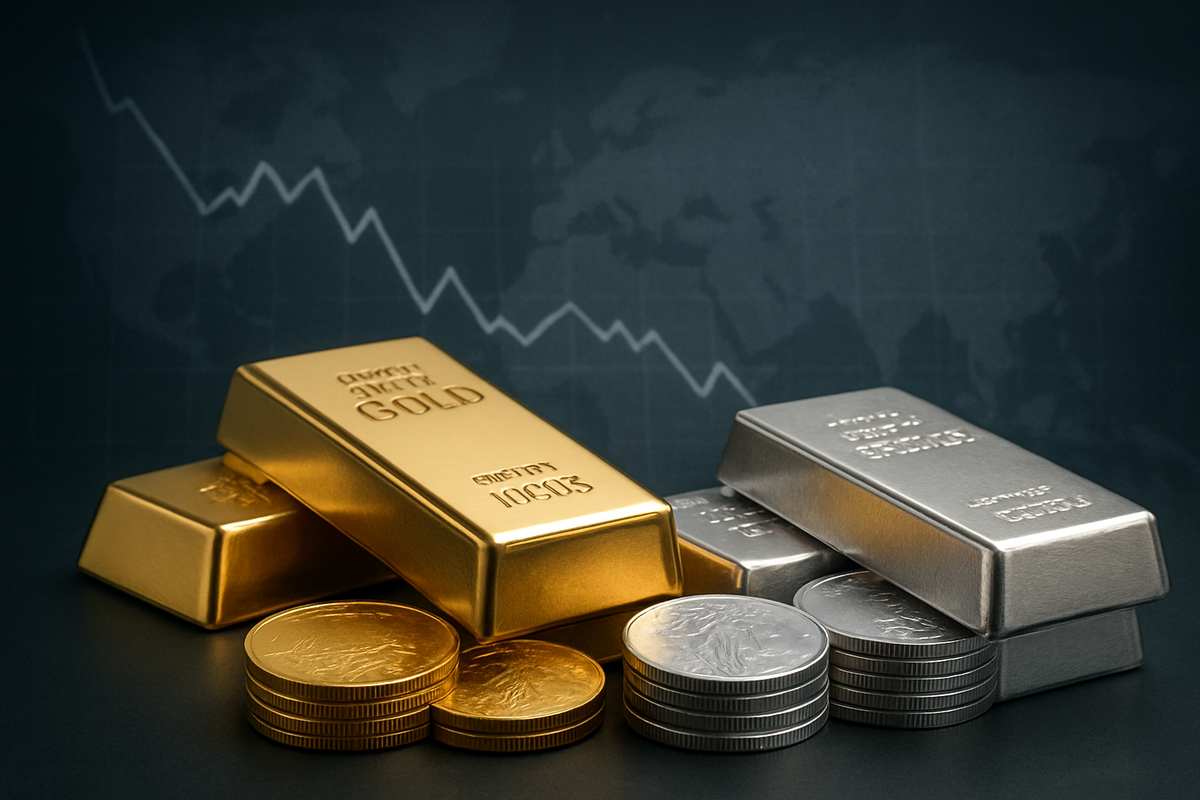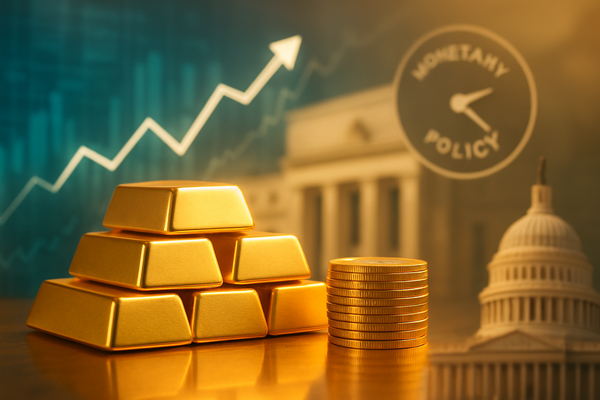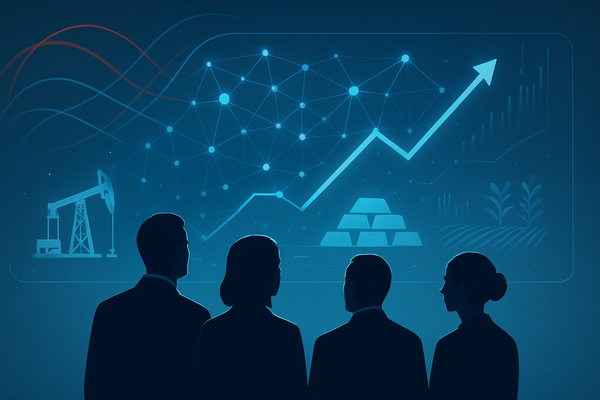Gold & Silver Surge Amidst ETF Outflows: A Market Paradox Explored

The global financial markets are currently grappling with a fascinating paradox: gold and silver prices have soared to multi-year highs, with gold briefly touching $4,400 per ounce and silver nearing $50 per ounce in 2025. This impressive rally unfolds even as some major precious metal-backed Exchange-Traded Funds (ETFs) have experienced net outflows in recent weeks. This divergence raises critical questions about the true drivers of demand for these safe-haven assets and where investor capital is truly flowing amidst a turbulent economic landscape.
This unusual market behavior suggests a sophisticated shift in investor sentiment and allocation strategies. While ETFs have historically been a popular vehicle for gaining exposure to precious metals, the current scenario indicates that other, perhaps more fundamental, demand channels are now exerting dominant influence. Understanding this dynamic is crucial for investors and policymakers alike, as it reflects deeper anxieties about global economic stability, inflation, and geopolitical risks, pushing capital towards tangible, traditional stores of value outside of conventional financial instruments.
The Unfolding Story: A Deeper Look at Precious Metals' Ascent
The year 2025 has been a landmark period for precious metals. Gold's journey saw it break past the $4,300 mark in October, even briefly peaking near $4,400 per ounce, while silver demonstrated an even more dramatic ascent, boasting a remarkable 73.7% year-to-date gain and touching $54.50 in late August before settling around $50 per ounce in early November. This rally was initially propelled by substantial inflows into precious metal ETFs during the early to mid-parts of 2025. Gold ETFs, for instance, saw their holdings climb to a seven-month high in August, and global gold ETF net inflows totaled a massive US$35.6 billion for the year, far surpassing previous periods.
However, the narrative began to shift in late October and early November 2025. Following the rapid price appreciation, major gold and silver ETFs such as SPDR Gold Shares (NYSEARCA: GLD), iShares Gold Trust (NYSEARCA: IAU), and SPDR Gold MiniShares (NYSEARCA: GLDM) observed net outflows. For example, GLD holdings dropped by nearly 8 tonnes after gold peaked around $4,360 an ounce. These outflows are largely interpreted as profit-taking by investors after an overheated climb, signaling a "corrective phase" within what many still view as a broader bull market. Despite these recent withdrawals from ETFs, prices have either consolidated at elevated levels or shown signs of rebounding, underscoring that the underlying demand for precious metals extends well beyond mere ETF movements.
The timeline of events highlights this nuanced picture: significant ETF accumulation fueled the initial surge, but subsequent, more recent outflows have not derailed the overall upward trajectory. This resilience points to powerful, persistent forces driving capital into gold and silver. Key players involved include a diverse range of market participants from central banks and institutional investors to retail buyers. Initial market reactions have been varied, with some analysts viewing the ETF outflows as a healthy consolidation, while others point to the strength of alternative demand channels as the true story.
Companies Riding the Wave: Winners and Losers in the Precious Metals Market
The surge in gold and silver prices, coupled with the shift in investment flows, creates a distinct landscape of winners and losers across the financial and mining sectors.
The most obvious beneficiaries are precious metal mining companies. Companies like Barrick Gold (NYSE: GOLD), Newmont Corporation (NYSE: NEM), and Wheaton Precious Metals (NYSE: WPM) are experiencing significantly higher revenues and profit margins due to elevated commodity prices. Gold and silver mining stocks have notably outperformed the broader market in 2025, with major gold stock ETFs like VanEck Gold Miners ETF (NYSEARCA: GDX) and VanEck Junior Gold Miners ETF (NYSEARCA: GDXJ) reportedly up over 100%. Investors seeking leveraged exposure to rising metal prices are increasingly shifting capital from direct metal ETFs into these equities, anticipating amplified returns. Silver miners, in particular, are seeing a double benefit from both higher prices and robust industrial demand for silver. Companies such as Pan American Silver (NASDAQ: PAAS) and First Majestic Silver (NYSE: AG) are well-positioned to capitalize on this trend.
On the other hand, companies heavily invested in or reliant on the stability of traditional financial assets, particularly those sensitive to interest rate hikes or a weakening US dollar, could face headwinds. While not direct "losers" from the precious metals surge itself, the underlying reasons for the surge—global economic uncertainty, inflation, and potential currency debasement—could negatively impact sectors like traditional banking, fixed-income investments, and certain growth-oriented technology companies that thrive in stable, low-inflation environments. Furthermore, ETFs providers who rely heavily on assets under management (AUM) for their fee structures, such as SPDR Gold Shares (NYSEARCA: GLD) and iShares Gold Trust (NYSEARCA: IAU), might see a temporary dip in revenue from management fees if outflows continue, although the higher metal prices could partially offset this by increasing the value of remaining holdings. However, the overall bullish sentiment for precious metals might eventually bring capital back into these vehicles, albeit perhaps with more discerning investor behavior.
Wider Significance: A Reflection of Global Economic Shifts
The current precious metals phenomenon is more than just a market anomaly; it is a profound reflection of broader industry trends and shifting global economic paradigms. The sustained bullish sentiment, despite intermittent ETF outflows, is underpinned by a confluence of critical factors.
Firstly, pervasive global economic uncertainty and geopolitical instability are driving a "flight to safety." Concerns over weakening US economic momentum and potential recession fears, coupled with a deteriorating US fiscal outlook and national debt concerns, are eroding confidence in traditional fiat currencies. Persistent inflation, which intensified in late 2024 and continued through 2025, further fuels the demand for hard assets as a hedge against eroding purchasing power. Geopolitical tensions, including ongoing conflicts, trade disputes, and political transitions, exacerbate this uncertainty, leading to a "debasement trade" where tangible assets like gold and silver are favored over paper assets.
Secondly, shifting central bank policies and interest rate expectations play a crucial role. Strong market expectations of a Federal Reserve interest rate cut in December 2025, driven by weak US economic indicators, significantly reduce the opportunity cost of holding non-yielding assets like gold and silver, making them more attractive. Broader monetary easing by central banks globally also creates a more favorable environment for precious metals. The consistent expansion of the M2 money supply, growing at nearly 5% annually, provides underlying support for precious metals as a hedge against currency devaluation. Notably, central banks globally, particularly in emerging economies, have been "voracious buyers" of gold, consistently increasing their reserves as part of strategic diversification efforts. Gold's share in sovereign reserves has surpassed the US dollar's for the first time since 1996, indicating a systemic shift away from dollar dominance.
Thirdly, US dollar weakness during the first half of 2025 has made dollar-denominated gold and silver more appealing to international buyers. Furthermore, silver's dual role as both a safe-haven asset and a critical industrial metal contributes significantly to its price appreciation. Robust demand from sectors like data centers, solar panels, and electronics, coupled with supply tightness, has fueled its rally. 2025 is expected to be the fifth consecutive year where silver demand outstrips supply, contributing to a structural deficit. This event fits into a broader trend of increased demand for "hard assets" and commodities, driven by long-term secular trends like the green energy transition and the Artificial Intelligence (AI) boom, both of which require significant industrial metals. Historically, periods of high inflation, geopolitical instability, and central bank monetary easing have consistently seen gold and silver perform strongly, reinforcing their role as crisis commodities.
What Comes Next: Navigating the Future of Precious Metals
Looking ahead, the trajectory of gold and silver prices will likely be shaped by the very forces that have propelled them to their current heights. In the short term, the market may experience continued volatility as investors digest economic data, central bank pronouncements, and geopolitical developments. Profit-taking from the recent rally could lead to further minor corrections, but the underlying demand drivers suggest these pullbacks may be shallow and brief. Investors should watch for further cues from the Federal Reserve regarding interest rate policy, as an actual rate cut in December 2025 or early 2026 could provide another significant boost to precious metals.
In the long term, the outlook for gold and silver remains robust. The ongoing de-dollarization trend among central banks, coupled with persistent global inflationary pressures and geopolitical fragmentation, will likely sustain a high level of demand for these traditional safe havens. Strategic pivots may be required from investors, shifting focus from short-term ETF flows to broader macroeconomic indicators and physical demand trends. Market opportunities could emerge in mining equities, particularly those with strong balance sheets and growth prospects, as they offer leveraged exposure to rising commodity prices. Additionally, the increasing industrial demand for silver, driven by the green energy transition and technological advancements, positions it for continued structural growth. Challenges may include potential government interventions, unexpected shifts in central bank policies, or a sudden de-escalation of geopolitical tensions, which could temporarily dampen the appeal of safe-haven assets. Potential scenarios range from a continued steady climb, punctuated by minor corrections, to more explosive surges if global economic and political uncertainties intensify.
Comprehensive Wrap-up: Enduring Significance and Investor Vigilance
In summary, the paradox of rising gold and silver prices amidst recent ETF outflows is not a contradiction but rather an evolution of market dynamics. While initial ETF inflows played a crucial role in the early 2025 rally, the subsequent outflows primarily represent profit-taking. The enduring strength of precious metals is now being driven by more fundamental and diversified demand channels: voracious central bank purchases, robust retail and institutional demand for physical bullion, significant capital reallocation into mining equities, and speculative flows in the futures market.
Moving forward, the market for gold and silver appears poised for continued strength. The key takeaways from this event are the undeniable influence of global economic uncertainty, persistent inflation, geopolitical instability, and a systemic shift in central bank asset allocation away from the US dollar. These factors collectively underscore the role of precious metals as essential hedges in a volatile world.
Investors should maintain a vigilant watch on several fronts in the coming months. Pay close attention to central bank policies, particularly the Federal Reserve's stance on interest rates, as well as inflation data and the trajectory of the US dollar. Geopolitical developments, especially those impacting global trade and stability, will also be critical indicators. Furthermore, monitor industrial demand trends for silver, as its dual utility makes it uniquely sensitive to both economic growth and safe-haven flows. For those seeking exposure, a diversified approach, considering physical bullion, well-managed mining equities, and strategic use of ETFs, may prove prudent in navigating this complex yet compelling market.
This content is intended for informational purposes only and is not financial advice



